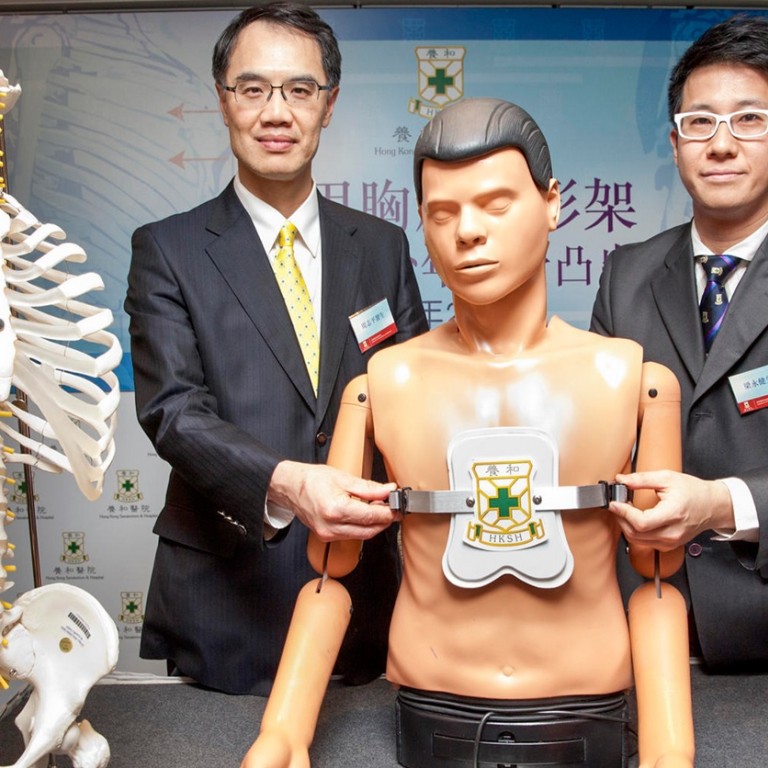
Simple treatment for pigeon chest gives young sufferers fresh hope
Pectus carinatum badly deforms its victims' chests. A new treatment is reshaping their rib cages and their lives, writes Jeanette Wang
As a child, Henry loved to swim. But when he realised how different he looked to other boys in a swimsuit, he just wanted to stay at home.
The 16-year-old was born with a deformity of the chest over the sternum, which gave him a bird-like appearance - a condition known as "pigeon chest" or pectus carinatum.
If you don't do anything about it, the condition won't get better by itself
"I saw I was different from others and felt embarrassed," says Henry, an only child whose name has been changed for reasons of patient confidentiality.
His mother scoured the internet for information about the condition and to find a treatment. She discovered a company in the US that makes chest orthoses that can correct the shape of the rib cage, in a similar way that braces can straighten crooked teeth.
Hong Kong Sanatorium and Hospital has offered the brace at its Prosthetic and Orthotics Unit since September 2011.
In October last year, Henry was fitted with the brace, which was custom made in the US for his bones. Within three months of constantly wearing the brace - except while showering - and with regular adjustments to increase its compression, the shape of his rib cage normalised.
He will continue to wear the brace until October, and is following a tailor-made exercise programme to ensure his bone structure stabilises.
"Usually, the condition keeps deteriorating until a person reaches skeletal maturity, which is at about 14 to 15 for girls and 16 to 18 for boys," says Dr Alex Chow Chi-ping, director of the hospital's department of physical medicine and rehabilitation. "If you don't do anything about it, the condition won't get better by itself."
About one in 1,000 teenagers have pectus carinatum, and it is more common in boys.
According to the US National Institutes of Health, the condition can occur on its own or with other genetic disorders or syndromes. Generally, it worsens during growth spurts in adolescence.
Apart from chest protrusion, other signs of the condition include uneven shoulders, excessive curvature (kyphosis) in the upper back or neck, and shoulder blades that stick out. Other conditions, such as scoliosis, may appear coincidentally.
Pectus carinatum decreases the expansion of the thoracic cavity during normal breathing, causing shortness of breath, chest pain, chest tightness and subsequently impairment of the cardiopulmonary function.
Chow says: "For more severe cases, patients may need to undergo surgery to reshape the rib cage by removing the rib cartilage and cutting the ribs. That will lead to unavoidable surgical risks and scarring."
To confirm the diagnosis, patients may need imaging studies, such as X-rays and CT scans of the chest, followed by an electrocardiogram and echocardiogram if co-existing cardiac diseases are suspected.
Mild cases are more of a cosmetic concern and may not need treatment at all.
Henry's deformity was moderate, but it was enough to affect his self-image. "I'm much more confident now," he says.
He is one of five teenage boys with the condition who have been treated at the hospital, the only local hospital to offer the brace.
Treatment usually lasts between 10 months and two years, with significant cosmetic improvement often seen at two months, says Chow. The success rate is higher than 90 per cent.
There are no significant side effects apart from discomfort if the brace is too tight or if the patient has a skin problem, Chow says.
None of the five teenage patients at the hospital had any serious side effects.
Weighing just 400 grams, the brace is not restrictive, says Keith Leung Wing-kin, a prosthetist and orthotist at the hospital. It is comfortable for most women, too, although those with fuller breasts may need some adjustments to the brace.
"It felt a bit uncomfortable in the beginning - a little tight around the chest, which restricted my breathing - but it's fine now," says Henry, who still plays basketball or squash in 10- or 15-minute bouts.
In a study published in the in 2012, 18 pectus carinatum patients with an average age of 12.9 years were treated with a dynamic chest-bracing device, worn for at least 20 hours a day for six months. Among the 13 patients who completed the six-month treatment, there was no recurrence of the condition.
In another study, published in the in 2008, 119 patients with an average age of 12.9 years wore a compressive brace all day for six months.
Only six patients had a relapse, four of whom had stopped wearing the brace.
All patients experienced discomfort when they first wore the brace. About 70 per cent had a skin rash and 15 per cent had skin discoloration due to excessive compression.
These conditions disappeared a few months after removal of the brace.
"The treatment is more effective for patients of age 10 or below, as their bones are more malleable," says Leung.
Chow estimates the two-year treatment to cost about HK$10,000 to HK$15,000. This includes the custom-made brace, continuous monitoring and frequent adjustments by an orthotist, and a tailor-made exercise programme with physiotherapists. Surgery would cost more than HK$100,000.
Complementing the brace with a rehabilitation exercise programme is essential to correct the effects of the condition, such as weak elasticity of soft tissues, uneven muscle strength, poor posture and weakened cardiopulmonary function, says Rainbow Law Ka-yee, senior physiotherapist at the hospital.
These exercises include stretching to increase the flexibility of soft tissues and the range of spinal movement; upper body weight training to correct muscle imbalance and strengthen shoulder muscles; abdominal exercises to strengthen the core and correct posture; and cardio workouts to improve cardiopulmonary function.

